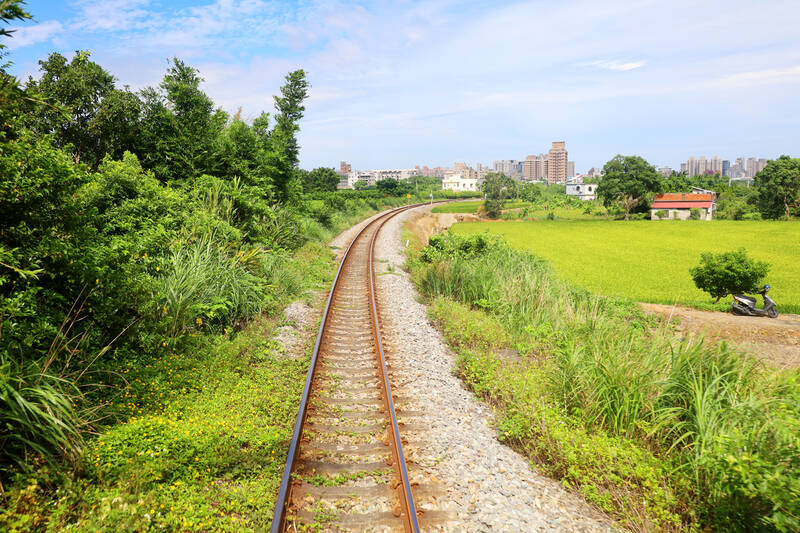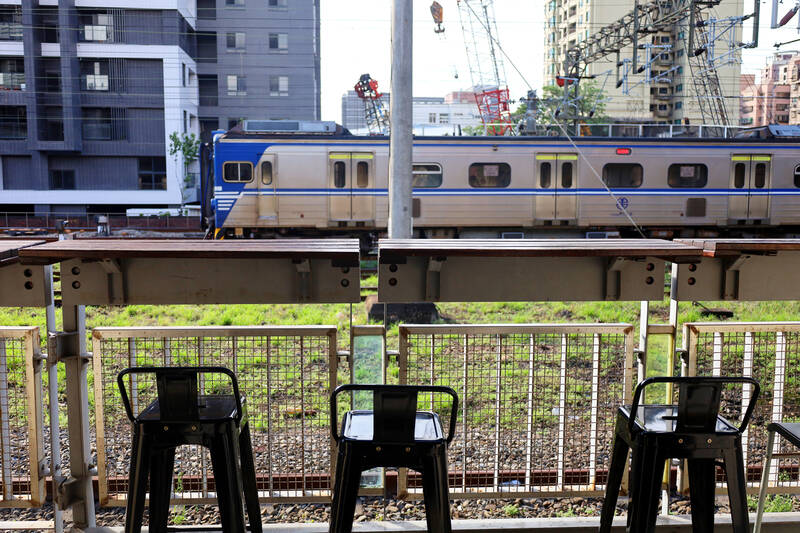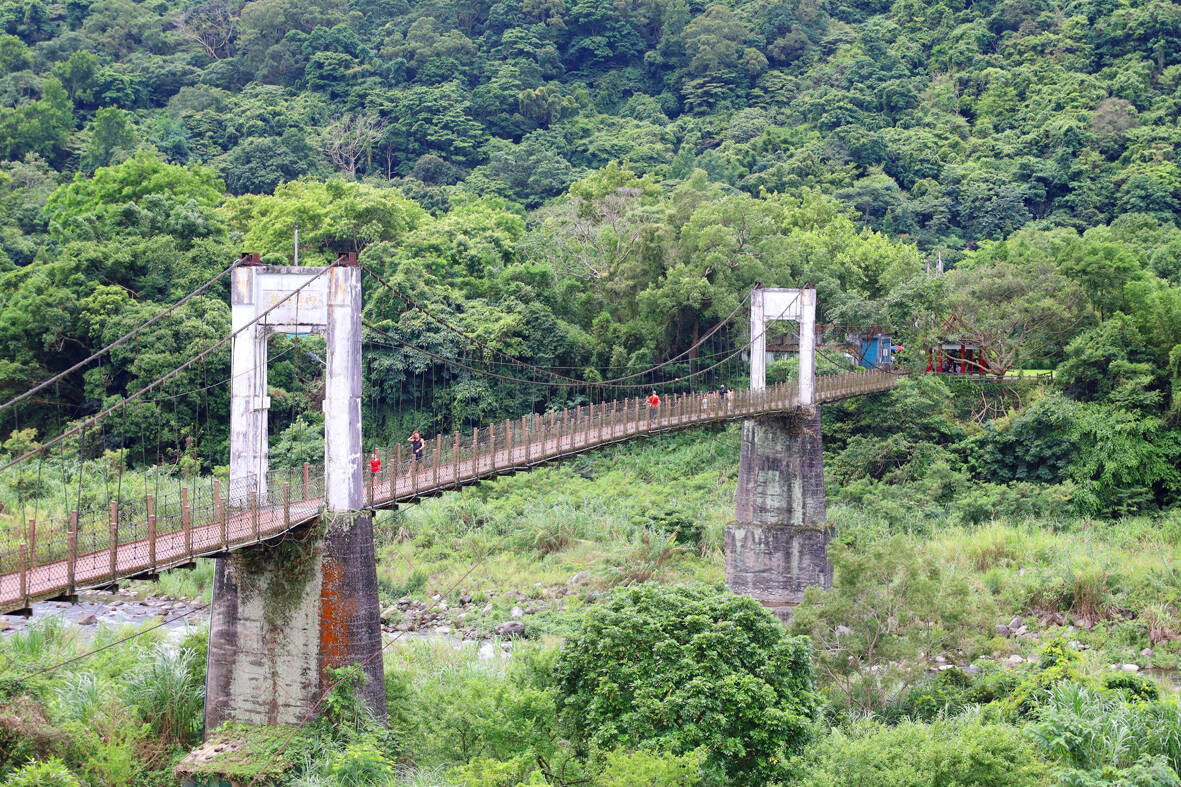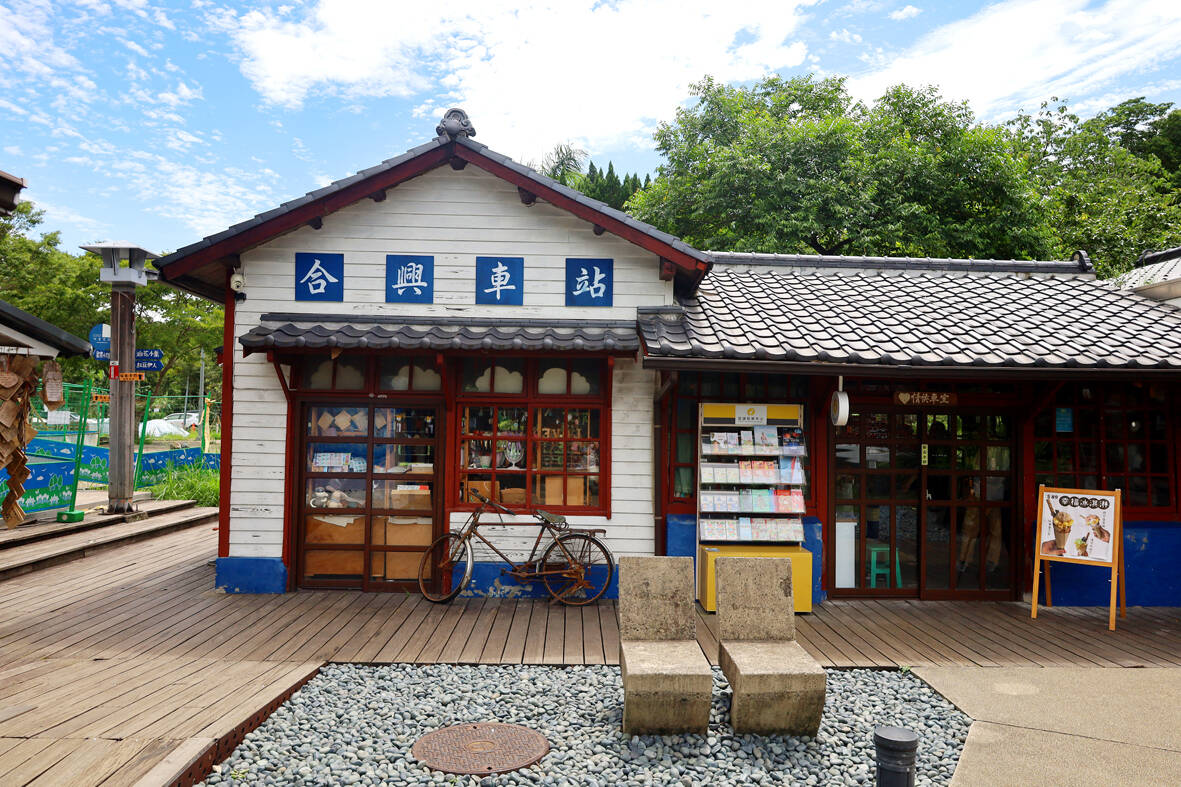A tourist plaque outside the Chenghuang Temple (都城隍廟) lists it as one of the “Top 100 Religious Scenes in Taiwan.” It is easy to see why when you step inside the Main Hall to be confronted with what amounts to an imperial stamp of approval — a dragon-framed, golden protection board gifted to the temple by the Guangxu Emperor that reads, “Protected by Guardians.”
Some say the plaque was given to the temple after local prayers to the City God (城隍爺) miraculously ended a drought. Another version of events tells of how the emperor’s son was lost at sea and rescued in Hsinchu, where it’s located.
What does seem certain is that the temple has stood here since 1748. Yet this is no museum-piece — it’s a living, incense-breathing, place of worship.

Photo: Thomas Bird, Taipei Times
Before ordering some noodles for dinner, I say a little prayer in the temple’s Main Hall, having been advised by an employee of the Hsinchu Railway Art Village (新竹市鐵道藝術村) — a repurposed trackside warehouse where I’d enjoyed an afternoon beverage — to seek the City God’s favor.
Her advice proves sage. The next morning I awake to azure skies after a week of plum rains, the sunshine bathing Hsinchu in a warm light.
Although the city is known for the manufacture of semiconductor chips, downtown is more historic than high-tech. Beyond the East Gate (東門), traditional medicine shops, antique houses, arcades and ancestral shrines line Beimen Old Street (北門老街) and other lanes that snake through the old quarter.

Photo: Thomas Bird, Taipei Times
Notwithstanding various Qing Dynasty heritage sites, the Japanese-era buildings are among Hsinchu’s most photogenic, including the red brick City Hall which is of 1920s vintage and the gray stone Image Museum (影像博物館), which had been Taiwan’s first luxury theater during its 1930s heyday.
Most striking of all the period buildings is Hsinchu Station (新竹車站). Were there a list of “Top 100 Railway Scenes in Taiwan” it would certainly chart in the top 10. Topped by a clocktower and built in the European style, it is the oldest active transport hub in Taiwan.
INLAND BOUND

Photo: Thomas Bird, Taipei Times
The north-bound train rolls out of Hsinchu Station passing a few local stations until it reaches Jhujhong (竹中) where passengers are instructed to cross the platform to board the Neiwan-bound train.
We’re now officially on the Neiwan branch line (內灣線), a 28km long track that dates back to 1941 when the local timber industry warranted an inland railroad.
Between Shangyuan (上員) and Ronghua (榮華) the track is half overgrown and framed by high-rise apartments scattered between neat parcels of rice and meadows of wild flowers.

Photo: Thomas Bird, Taipei Times
According to the map I acquired from the Visitor Information Center in Hsinchu Station, there’s only one large settlement on the line, Jhudong (竹東), a township on the left bank of the Touqian River (頭前溪), where I decide to stretch my legs.
It’s not long before I’m lost amidst the hubbub of Jhongyang Central Market (中央市場). Street stalls hemmed between the Opera Park and an old Catholic Church are hawking everything from herbal jellies to exotic fruits. The chatter in the local language, as locals haggle over prices, is a reminder that this upland area is dominated by Hakka folk, who are culturally distinct from the Hoklo-speakers (more commonly known as Taiwanese) of the coast.
Not far from the market, there’s an innocuous, lime-colored house, framed by bamboo groves and fronted by palm trees, namely, the Timber Industry Exhibition Hall (竹東林業展示館), which is free to enter.

Photo: Thomas Bird, Taipei Times
“The timber industry had once been one of the industries that brought prosperity to Jhudong Township,” I read inside, before learning how a Japanese timber trader named Hirato Hoshino founded a mill and pine wood export company in 1940.
The following year construction of the branch railway began to transport cement inland and timber to the coast. It was eventually completed in 1951 due to interruption of World War II. This was the genesis of an industry that would, by the 1960s, boast 36 timber trade companies and eight bamboo trade companies, all of them based in Jhudong. The businesses prospered until the 1980s when “the government announced logging restrictions” and in 1993 the last mill closed down.
Nowadays, thankfully, conservation is the order of the day, evident in the abundant green vegetation that fringes the tracks.
We roll on, tracing the Touqian River up-stream into altogether wilder terrain until we get to Hesing Station (和興) where the wooden stationhouse is a popular selfie spot.
Hesing has a story to tell, according to the friendly Visitor Information Center employee Luby Lin (林佩如).
“This station is all about romance,” she explains. “Young couples come here to have their photos taken because of a popular love story”
When I ask her for more details, she tells me the tale of a local boy surnamed Tseng (曾).
“Mr. Tseng caught the train every day and sat beside his high school sweetheart. But on the last day of school, he overslept and missed the train. He’d long dreamt of graduating in the company of the girl he loved, so he ran after the train, finally catching up with it at Jioucantou Station (九讚頭). The story ended happily, he passed his final exam and won the girl’s heart.”
The man later founded a school, she tells me, becoming a respected member of the local community.
END OF THE LINE
I too almost miss the train, although not for romantic reasons. It arrives as I’m slurping a drink inside a disused passenger car that has been refashioned as a cafe.
A quick dash and some spilled coffee gets me back on track.
Alighting 10 minutes later at the terminus station, Neiwan (內灣), I find myself in a tourist town par excellence.
There’s a cabaret group performing a classic Teresa Teng (鄧麗君) number in the station forecourt. The main throughfare, Neiwan Old Street (內灣老街), is packed with sightseers sampling Hakka delicacies like wild ginger flower glutinous rice dumplings and peony brown sugar cakes. And everyone seems to be here for a group photo before one of the picturesque buildings that dot the logging town turned “scenic area.”
“While the Neiwan Branch Line’s cargo was once timber, it is now sightseers,” I jot in my diary before wandering over to the Guangji Temple (廣濟宮), the religious focal point of town.
Following some lantern-lined steps, I find my way to some faded narrow-gauge tracks outside the old Forest Bureau Building.
There’s another railway heritage site situated just past the station, a wheelhouse that would have been used to turn locomotives around in the age of steam.
Beyond the wheelhouse, the road leads to the precipice of a valley, where visitors are awarded with soaring vistas enjoyed to the soundtrack of insect chatter and birdsong.
Wishing to escape the crowds, I cross the suspension bridge that traverses the Youluo River (油羅溪). On the other side, there’s a pavilion, a perfect setting to meditate on the mountain forests that still carpet the surrounding hills that mark the very end of the Neiwan branch line.

Nov. 11 to Nov. 17 People may call Taipei a “living hell for pedestrians,” but back in the 1960s and 1970s, citizens were even discouraged from crossing major roads on foot. And there weren’t crosswalks or pedestrian signals at busy intersections. A 1978 editorial in the China Times (中國時報) reflected the government’s car-centric attitude: “Pedestrians too often risk their lives to compete with vehicles over road use instead of using an overpass. If they get hit by a car, who can they blame?” Taipei’s car traffic was growing exponentially during the 1960s, and along with it the frequency of accidents. The policy

While Americans face the upcoming second Donald Trump presidency with bright optimism/existential dread in Taiwan there are also varying opinions on what the impact will be here. Regardless of what one thinks of Trump personally and his first administration, US-Taiwan relations blossomed. Relative to the previous Obama administration, arms sales rocketed from US$14 billion during Obama’s eight years to US$18 billion in four years under Trump. High-profile visits by administration officials, bipartisan Congressional delegations, more and higher-level government-to-government direct contacts were all increased under Trump, setting the stage and example for the Biden administration to follow. However, Trump administration secretary

In mid-1949 George Kennan, the famed geopolitical thinker and analyst, wrote a memorandum on US policy towards Taiwan and Penghu, then known as, respectively, Formosa and the Pescadores. In it he argued that Formosa and Pescadores would be lost to the Chine communists in a few years, or even months, because of the deteriorating situation on the islands, defeating the US goal of keeping them out of Communist Chinese hands. Kennan contended that “the only reasonably sure chance of denying Formosa and the Pescadores to the Communists” would be to remove the current Chinese administration, establish a neutral administration and

A “meta” detective series in which a struggling Asian waiter becomes the unlikely hero of a police procedural-style criminal conspiracy, Interior Chinatown satirizes Hollywood’s stereotypical treatment of minorities — while also nodding to the progress the industry has belatedly made. The new show, out on Disney-owned Hulu next Tuesday, is based on the critically adored novel by US author Charles Yu (游朝凱), who is of Taiwanese descent. Yu’s 2020 bestseller delivered a humorous takedown of racism in US society through the adventures of Willis Wu, a Hollywood extra reduced to playing roles like “Background Oriental Male” but who dreams of one day